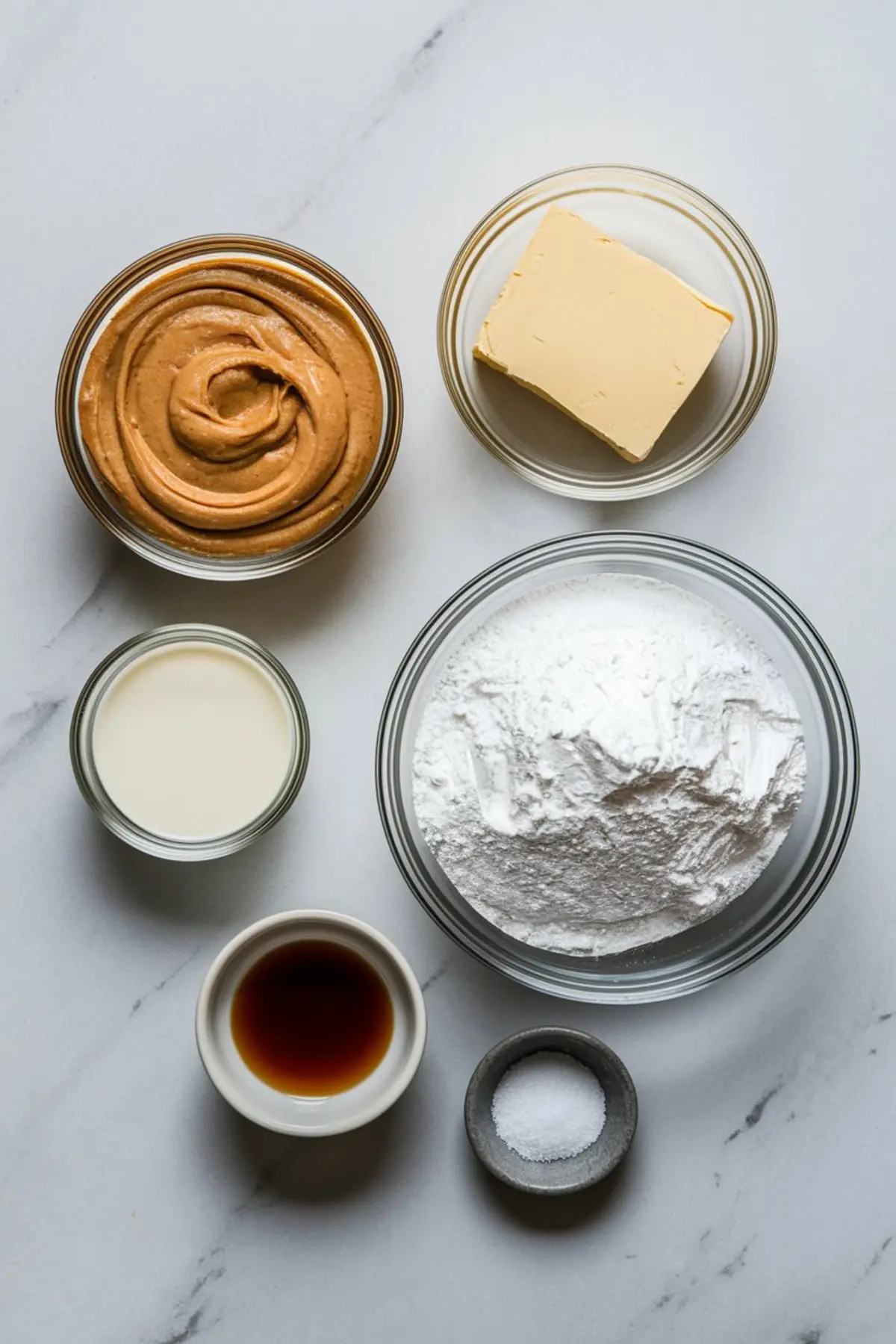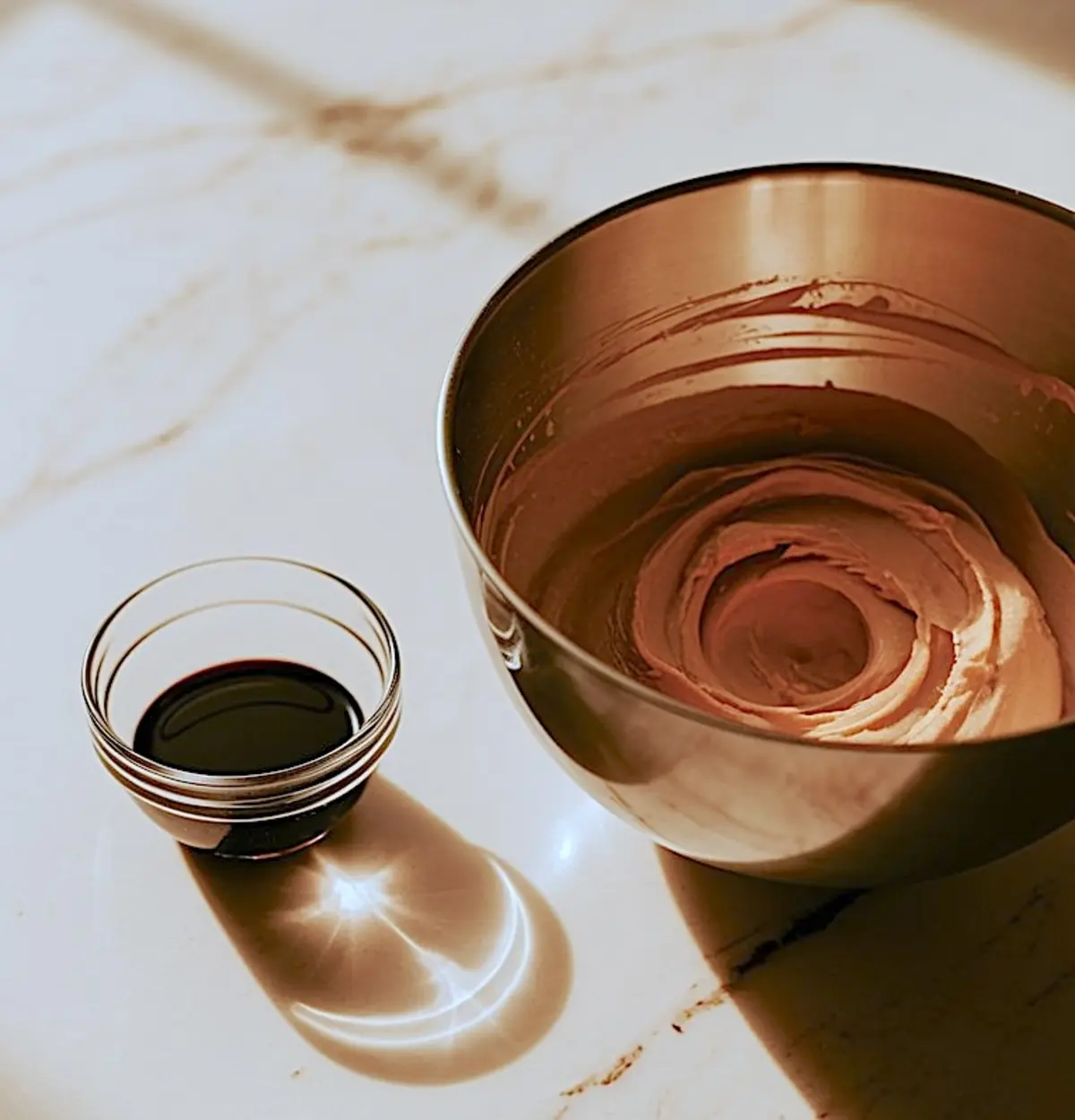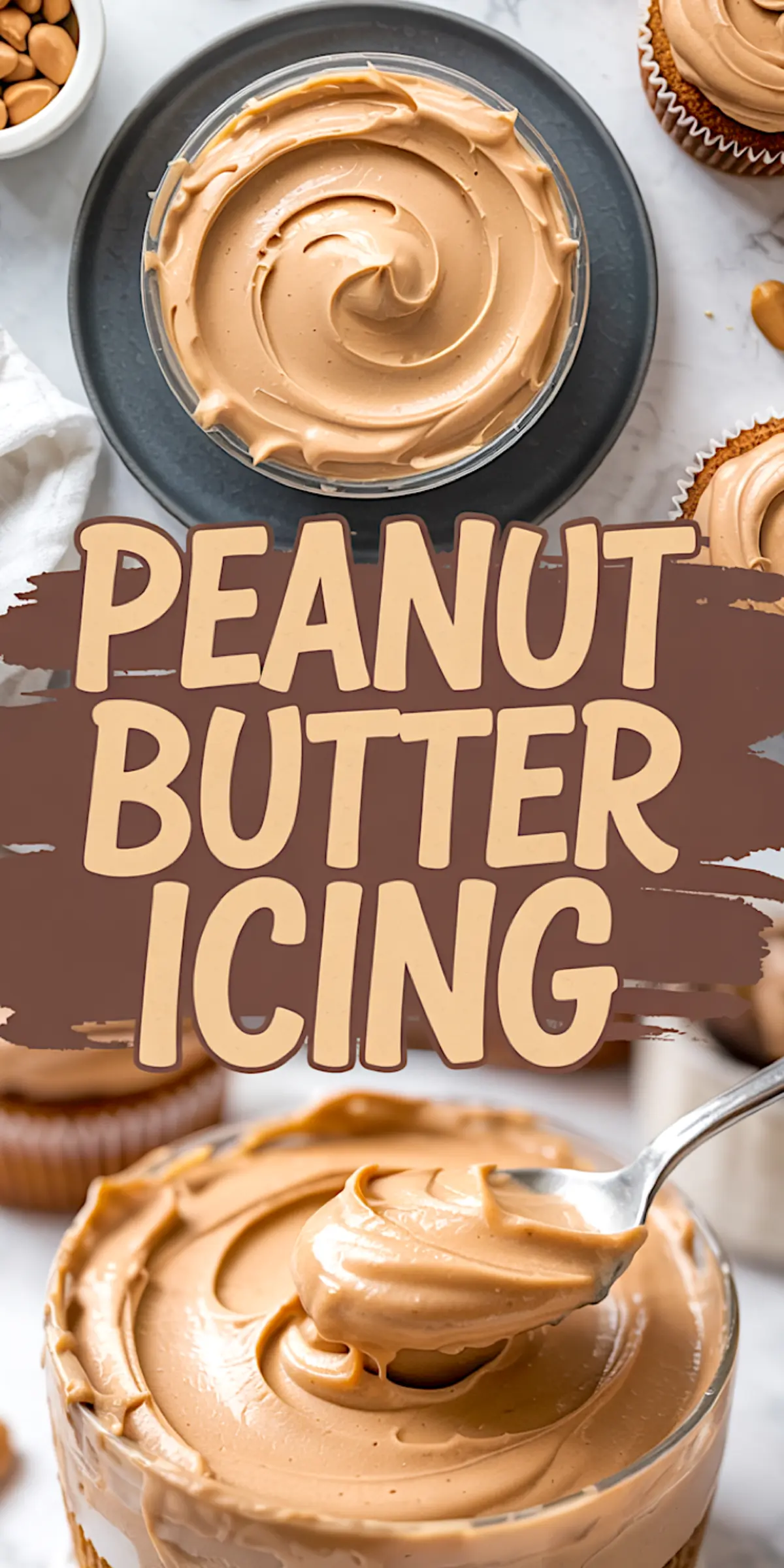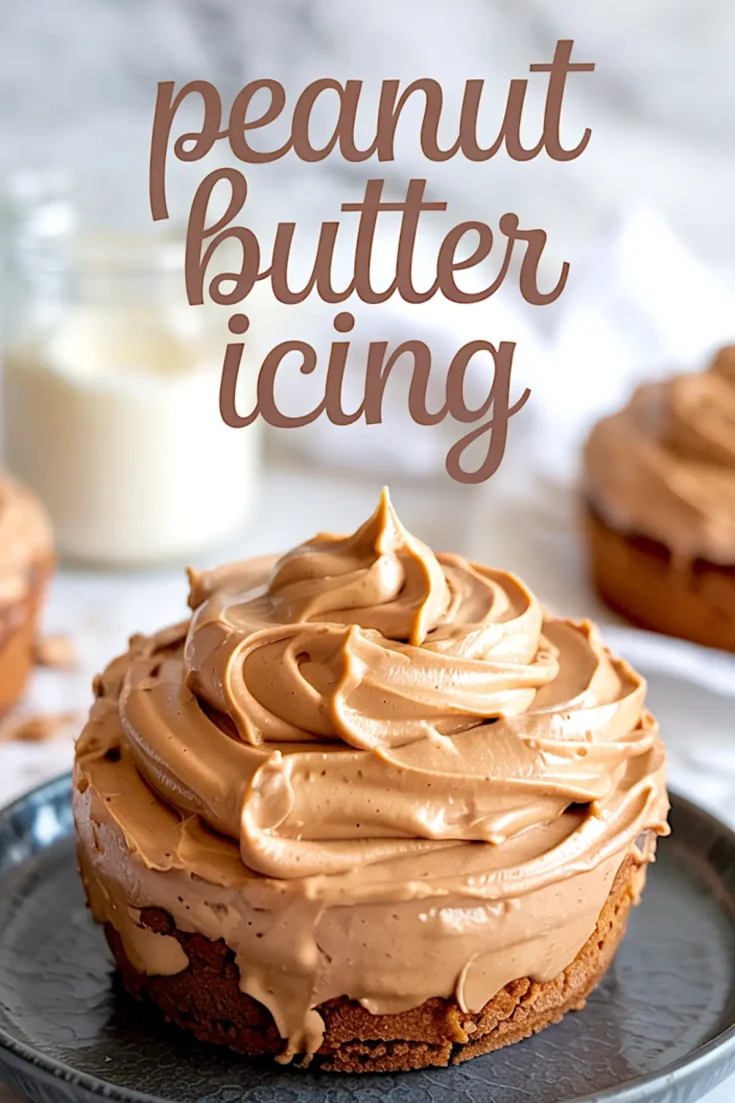I have tested countless versions of peanut butter frosting over the years. Some tasted too sweet, some felt too greasy, others wouldn’t hold up on layer cakes or cupcakes. I wanted one recipe that delivers the right texture every time. This is that recipe.
You will learn exactly how to make a stable peanut butter icing that spreads easily, pipes cleanly, and carries a rich, balanced flavor. I will also share my personal tips on ingredient choices and storage that make a real difference.

Why This Peanut Butter Icing Works Every Time
The core of this recipe is balance. Peanut butter naturally brings fat, protein, and salt. Powdered sugar adds sweetness and structure. Butter adds creaminess and volume. Heavy cream adjusts the final texture.
Using conventional creamy peanut butter, like Jif or Skippy, gives this icing its consistent texture. I have tested natural peanut butters, but they separate too easily. The oil pools and the frosting breaks. Commercial creamy brands keep the emulsion stable.
I chose unsalted butter to control the overall saltiness. The small pinch of salt at the end allows you to fine-tune the flavor once you taste the mixed icing.
Ingredients For Smooth Peanut Butter Buttercream Frosting

Start with creamy peanut butter. Make sure it is not the natural variety. You need one full cup.
Add softened unsalted butter. Half a cup works best. The butter must be soft but not melted.
Prepare two cups of sifted powdered sugar. Sifting helps prevent lumps and keeps the texture smooth.
Have three to four tablespoons of heavy cream or whole milk ready. The liquid allows you to control consistency.
Include one teaspoon of pure vanilla extract. It rounds out the flavors.
Keep a small pinch of salt nearby. You may or may not need it depending on your peanut butter.
Creaming The Butter And Peanut Butter Together

I start by beating the peanut butter and softened butter together. Two to three minutes on medium speed gives a smooth and fluffy base. The air incorporated during this step helps with the frosting’s spreadability later.
I never rush this part. If you leave lumps here, they only get harder to fix once the sugar goes in.
Incorporating Vanilla And Powdered Sugar Gradually

After the base is fluffy, I mix in the vanilla extract.
Then I add the powdered sugar in small portions, about half a cup at a time. Starting the mixer on low prevents powdered sugar clouds. Once each portion blends in, I increase to medium-high speed.
Adding the sugar slowly allows it to dissolve fully, giving the icing its smooth, creamy body.
Adjusting The Consistency With Heavy Cream Or Milk

This is where you take control based on how you plan to use the frosting.
For spreading on cakes or bars, I add three tablespoons of cream. The frosting stays soft and easy to spread.
For piping or filling layer cakes, two tablespoons keep it firmer and hold sharp edges better.
In my notes, I have tried both. The difference is noticeable. More liquid gives a silkier spread. Less keeps the swirls neat on cupcakes.
Tasting And Balancing The Salt
At this stage, I always taste a small spoonful. If my peanut butter was unsalted or mild, I add a pinch of salt. This small addition makes the peanut butter flavor brighter without making the frosting salty.
How To Store Peanut Butter Frosting Without Losing Texture
Use the frosting immediately for best spreadability.
If you need to store it, cover tightly. At room temperature, it holds for up to 24 hours. Beyond that, refrigerate.
Refrigerated frosting firms up. Before using, bring it back to room temperature and beat it briefly to restore the soft texture.
How I Use This Peanut Butter Frosting On Different Desserts
This recipe works beautifully across many desserts.
On cupcakes, it pipes smooth domes that hold their shape. Try it on my Chocolate Peanut Butter Cupcakes.
For brownies, the peanut butter frosting adds a creamy layer that contrasts with the dense chocolate base. If you need a base brownie, top it with this frosting as your own Peanut Butter Frosting For Brownies.
For peanut butter lovers, you can also use it as a Peanut Butter Filling For Cake. I have layered it between chocolate cake layers with great results.
If you want more frosting options, my Best Peanut Butter Frosting covers some variations you might enjoy.
Ingredient Comparison: Heavy Cream vs Whole Milk
I have tested both heavy cream and whole milk many times.
Heavy cream produces a richer, silkier frosting. The higher fat content creates a smoother mouthfeel.
Whole milk works when heavy cream is unavailable. It still creates a spreadable frosting but feels lighter on the tongue and slightly looser in structure.
For layer cakes or piping where structure matters, I always reach for heavy cream. For casual spreads on bars or brownies, whole milk does fine.
Serving And Presentation Tips
Peanut butter icing pairs well with dark chocolate desserts, banana cakes, or even simple vanilla layers.
For a polished look, I like to swirl it using a large open star tip. The frosting holds ridges cleanly, creating a professional appearance without extra effort.
As a drizzle, thin it slightly with additional cream. You get a smooth Peanut Butter Drizzle Recipe that works well over cheesecake or ice cream.
You may also enjoy pairing it with my Peanut Butter Pie or my easy Cream Cheese Frosting for layered dessert bars.
For chocolate lovers, try my Chocolate Frosting as a companion option.
Final Thoughts And Invitation To Share

Now you have a reliable Peanut Butter Buttercream Frosting that adapts for spreading, piping, filling, or drizzling. I’ve refined this method through many test batches and dozens of desserts.
Pin this recipe now to save it for your next cake or batch of cupcakes.
And if you try it, share your results or questions in the comments below. I enjoy hearing how you use these recipes and am always happy to offer more advice if you need adjustments.
Peanut Butter Icing Recipe

This peanut butter icing is rich, creamy, and smooth with a balanced salty-sweet flavor. It spreads easily on cakes, pipes well on cupcakes, and works perfectly as a filling or frosting for cookies and bars. It requires just a few simple ingredients and comes together in one bowl in under 10 minutes.
Ingredients
- 1 cup creamy peanut butter (not natural style; use Jif or Skippy)
- ½ cup unsalted butter, softened
- 2 cups powdered sugar, sifted
- 3–4 tablespoons heavy cream or whole milk
- 1 teaspoon pure vanilla extract
- Pinch of salt (optional, to taste)
Instructions
- CREAM THE BUTTER AND PEANUT BUTTER: In a large mixing bowl, beat the softened butter and peanut butter together on medium speed for 2 to 3 minutes until smooth, fluffy, and fully blended.
- ADD THE VANILLA: Mix in the vanilla extract until evenly incorporated.
- INCORPORATE THE POWDERED SUGAR: Add the sifted powdered sugar gradually, about ½ cup at a time. Start on low speed to avoid a sugar cloud, then increase to medium-high as the mixture thickens. Continue beating until the icing is thick and smooth.
- ADJUST CONSISTENCY: Add heavy cream or milk one tablespoon at a time, beating between each addition, until the icing reaches your preferred consistency. Use 3 tablespoons for a spreadable texture or 2 tablespoons for a firmer piping consistency.
- TASTE AND ADD SALT IF NEEDED: Taste the icing. If your peanut butter is unsalted, add a small pinch of salt to enhance the flavor.
- READY TO USE: Use the icing immediately to frost cakes, cupcakes, brownies, or cookies. If not using right away, cover and store at room temperature for up to 24 hours or refrigerate for longer storage.
Notes
Use conventional creamy peanut butter for the best texture and stability. Natural peanut butters tend to separate and result in an oily or inconsistent frosting.

